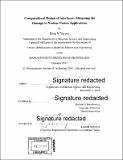| dc.contributor.advisor | Michael J. Demkowicz. | en_US |
| dc.contributor.author | Yuryev, Dina V | en_US |
| dc.contributor.other | Massachusetts Institute of Technology. Department of Materials Science and Engineering. | en_US |
| dc.date.accessioned | 2017-05-11T19:58:15Z | |
| dc.date.available | 2017-05-11T19:58:15Z | |
| dc.date.copyright | 2017 | en_US |
| dc.date.issued | 2017 | en_US |
| dc.identifier.uri | http://hdl.handle.net/1721.1/108966 | |
| dc.description | Thesis: Ph. D., Massachusetts Institute of Technology, Department of Materials Science and Engineering, 2017. | en_US |
| dc.description | Cataloged from PDF version of thesis. | en_US |
| dc.description | Includes bibliographical references (pages 117-125). | en_US |
| dc.description.abstract | In order for nuclear fusion to be a feasible source of energy, materials must be developed that are resistant to the damaging byproducts of a fusion reaction. One of these byproducts is He, that is implanted into the plasma facing wall of the reactor. Once implanted, it causes irreparable damage due to it's insolubility in the material: the He cannot escape in a non-destructive manner. In this thesis, an interface in a layered metal nanocomposite is designed to have desirable precipitation properties, specifically that He precipitates will link up to form stable, continuous pathways. Once in these channels, the He may still migrate within the channels themselves. Thus, channels that terminate at free surfaces may enable controlled He removal via outgassing, thereby averting He-induced damage. In this thesis, computational methods are developed for identifying promising interfaces that give rise to He channels and for modeling He network behaviors at these interfaces. These models are then applied to materials systems of interest to determine if elongated precipitates arise. Finally, experimental results are presented that support computational predictions that Cu-V interfaces result in linear helium channels. | en_US |
| dc.description.statementofresponsibility | by Dina V. Yuryev. | en_US |
| dc.format.extent | 125 pages | en_US |
| dc.language.iso | eng | en_US |
| dc.publisher | Massachusetts Institute of Technology | en_US |
| dc.rights | MIT theses are protected by copyright. They may be viewed, downloaded, or printed from this source but further reproduction or distribution in any format is prohibited without written permission. | en_US |
| dc.rights.uri | http://dspace.mit.edu/handle/1721.1/7582 | en_US |
| dc.subject | Materials Science and Engineering. | en_US |
| dc.title | Computational design of interfaces : mitigating He damage in nuclear fusion applications | en_US |
| dc.title.alternative | Mitigating Helium damage in nuclear fusion applications | en_US |
| dc.type | Thesis | en_US |
| dc.description.degree | Ph. D. | en_US |
| dc.contributor.department | Massachusetts Institute of Technology. Department of Materials Science and Engineering | |
| dc.identifier.oclc | 986491819 | en_US |
